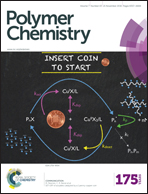Synthesis of a glucose oxidase-conjugated, polyacrylamide-based, fluorescent hydrogel for a reusable, ratiometric glucose sensor†
Abstract
The glucose level is a critical issue for individuals with diabetes, and thus selective and efficient detection of glucose is very important. A variety of optical techniques for the detection of glucose in solution have been reported. However, an effective, reversible, and reusable probe for glucose monitoring still remains a challenge. A new hydrogel sensor based on a copolymer was developed. The copolymer consisted of acrylamide and fluorescent monomers of fluorescein and rhodamine B, in which glucose oxidase (GOx) was immobilized on the resultant hydrogel and showed effective fluorescence-sensing performance toward glucose. GOx was immobilized on the hydrogel either by simple mixing or by covalent bonding to improve enzyme stability. The fluorophores of both fluorescein and rhodamine B moieties were pH-responsive and could change their fluorescence colors with pH changes. The change in the pH of the glucose solution was attributed to the hydrolytic decomposition of glucose, induced by the action of GOx. Upon exposure to glucose, the sensing hydrogel induced visual changes in fluorescence colors that could be identified by the naked-eye. The hydrogel sensor showed a highly reproducible response toward glucose and could be reused even after rinsing with buffer solution because of the robust covalent bond between the hydrogel and GOx. This work provides a facile and promising strategy for constructing a stable, naked-eye-detectable optical protocol that offers sensor reusability for glucose detection.


 Please wait while we load your content...
Please wait while we load your content...